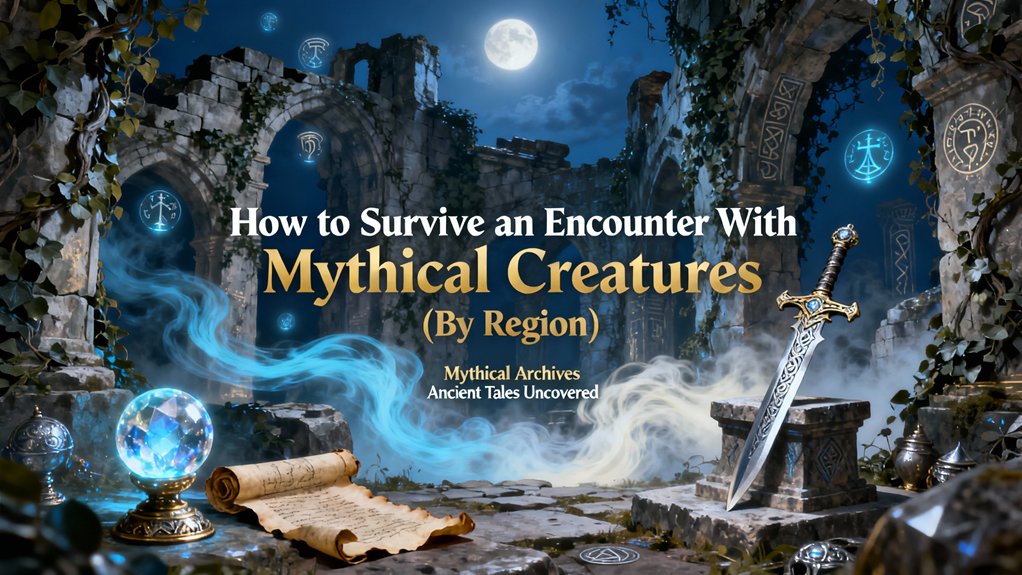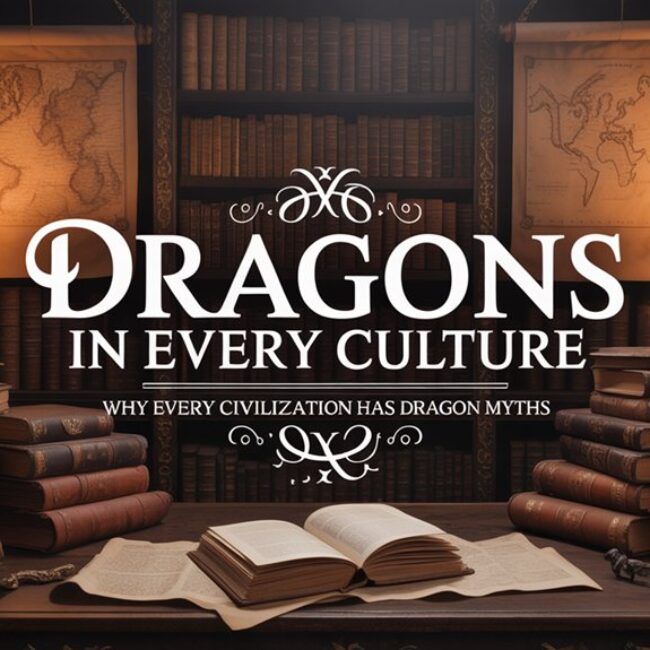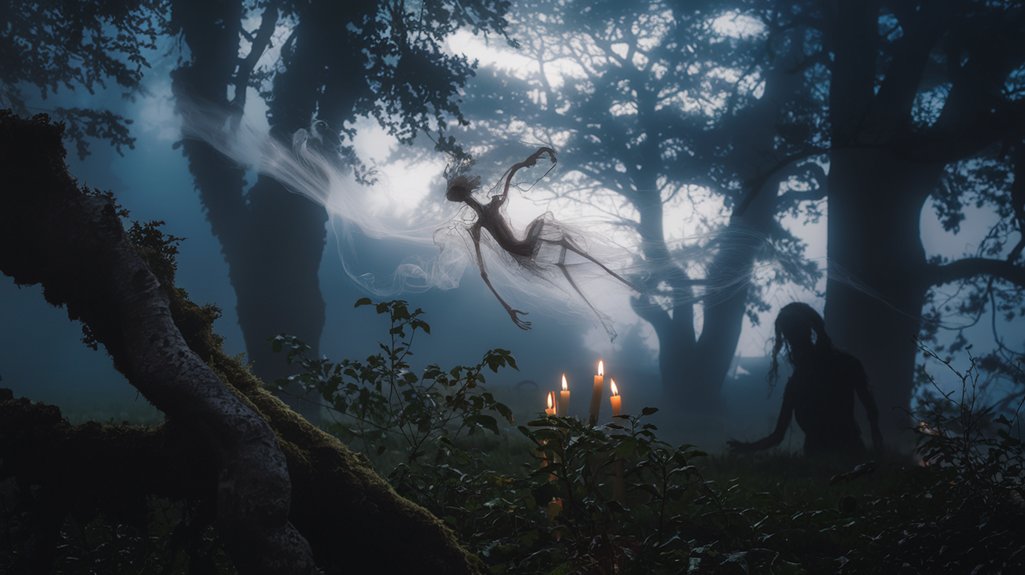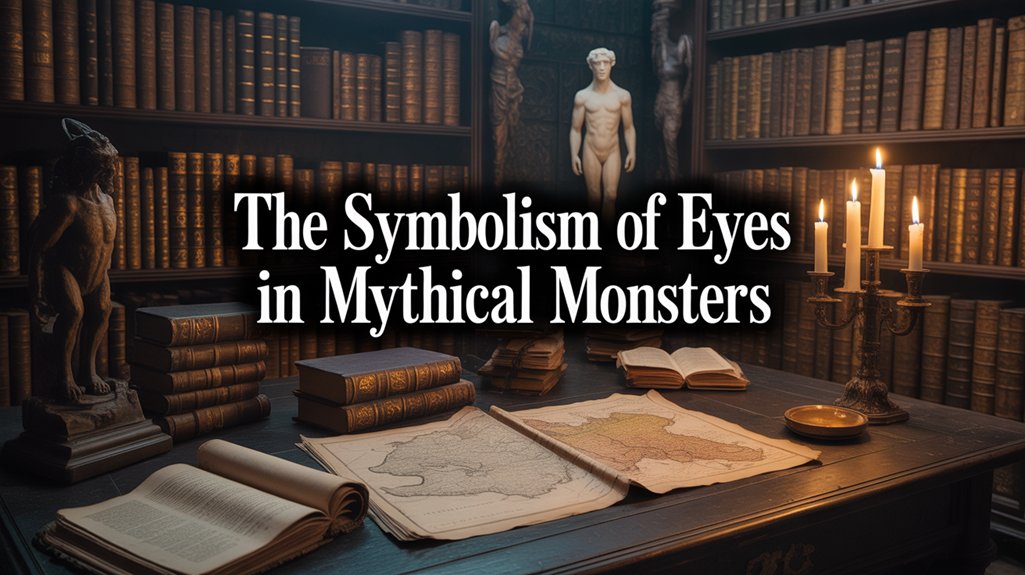
You’ll survive mythical encounters through region-specific protocols: avoid mounting kelpies near Highland lochs, maintain salt circles against shapeshifters during twilight alterations, respect Amazonian Curupira’s backward footprints marking sacred groves, employ polished bronze shields against Mediterranean Gorgon petrification, offer sake to Asian Tengu guardians at mountain thresholds, and recognize North American Thunderbird arrival through atmospheric pressure drops. Each culture independently developed chimeric defense systems—silver for European werewolves, white ash for Navajo skin-walkers, fire circles for Algonquian wendigos—that demonstrate uncanny consistency across continents. The ancient boundaries demand vigilance, reverence, and precise understanding of territorial jurisdictions these eldritch guardians enforce.
Table of Contents
Toggle🔮 Enhance Your Practice With These Essentials
Chosen for ritual alignment and energetic correspondence.
Key Takeaways
- European water spirits: Never accept gifts or rides from beings near water after dusk; use salt circles and blessed iron for protection.
- South American jungle: Respect sacred groves and hunt with reverence; Curupira and Mapinguari enforce ancient ecological laws in their territories.
- Asian mountains: Maintain fire, offer sake to Tengu, and avoid avalanche corridors in Yeti regions; hold breath near Jiangshi.
- North American plains: Use turquoise charms and salt circles against Skinwalkers; watch for unnatural stillness indicating Thunderbird proximity.
- Mediterranean/Gorgon encounters: Use polished shields or mirrors for indirect viewing; never establish direct eye contact to avoid petrification.
European Water Spirits: Surviving Kelpies, Nixies, and Rusalka

Since the earliest Germanic and Slavic settlements formed along riverbanks and lakeshores, the waters of Europe have harbored predatory spirits whose allure proves as deadly as their intent.
🎯 Recommended Products
Handpicked items related to this article:
As an Amazon Associate, we earn from qualifying purchases.
Understanding kelpie characteristics proves essential: these Scottish shape-shifters manifest as magnificent horses near Highland lochs, their skin perpetually damp, their eyes reflecting an eldritch intelligence that betrays their chimeric nature. You’ll recognize their invitation to mount them—resist.
Nixie habitats concentrate throughout Germanic river systems, particularly the Rhine and Elbe, where these water nymphs have drowned the unwary since pre-Christian times. They’re bound to specific territories.
Rusalka legends pervade Eastern European consciousness, describing vengeful spirits of drowned maidens who emerge during Rusal’naya Week, typically early June.
Water spirit folklore emphasizes one survival principle: never accept gifts, rides, or invitations from beings encountered near water after dusk. Your autonomy depends on recognizing manipulation masked as beauty. These mythical creatures share common roles within their respective cultural narratives as boundary guardians between the mortal realm and the dangerous depths below.
Shapeshifters of the Forest: Werewolves, Skin-Walkers, and Wendigos
The shapeshifters of the forest occupy a particularly eldritch category among cryptid entities, their metamorphic nature rendering conventional identification methods obsolete until the alteration has already commenced.
When confronting potential therianthropes—whether the lunar-bound lycanthropes of medieval Europe, the yee naaldlooshii of Diné cosmology, or the cannibalistic wendigo spirits of Algonquian territories—you must recognize that each culture’s protective methodologies emerge from centuries of documented encounters, preserved through oral traditions that deserve rigorous scholarly attention.
The physical transmutation itself manifests through specific prodromal signs: skeletal restructuring, dermatological anomalies, behavioral aberrations that precede the complete metamorphosis into something fundamentally chimeric. While Greek mythology’s Pan was born with fully developed horns, beard, and goat-like features—representing a fixed hybrid form rather than transformation—this exemplifies how ancient cultures understood the permanence of certain bestial characteristics in beings that bridged the human and animal realms.
Recognizing Physical Transformation Signs
When confronting entities that occupy the threshold between human and beast, your survival depends upon recognizing the subtle corporeal aberrations that precede full change.
Watch for alteration indicators: elongating canines that pierce previously human gums, fingers that curve into talons mid-gesture, pupils that dilate into vertical slits.
The physical changes manifest differently across traditions—werewolves exhibit excessive hair growth and skeletal restructuring, skin-walkers demonstrate chimeric melding of animal features, wendigos display emaciation and frost-touched flesh.
Notice behavioral shifts first: erratic movement patterns, involuntary twitching, sudden temperature fluctuations in their vicinity.
These eldritch manifestations, documented in Algonquian accounts from the 1630s and European lycanthropy trials throughout medieval centuries, provide vital warning windows.
Your autonomy—indeed, your very existence—requires constant vigilance during twilight hours when these alterations peak.
Defensive Measures and Deterrents
Recognition alone offers no protection against those who wear borrowed skins.
You’ll need tangible defenses—magical wards etched in silver, protective charms woven from mountain ash and wolfsbane.
European traditions emphasize blessed iron; Native American protocols require sacred tobacco, prayers spoken in ancestral tongues.
These aren’t superstitions but survival protocols refined across centuries.
Salt circles work.
So do mirrors positioned to reflect chimeric forms back upon themselves, forcing recognition of their eldritch nature.
Fire remains paramount—not mere flame, but consecrated pyres that honor the alteration’s origins while rejecting its malevolent expression.
Distance matters most.
When wards fail, when charms shatter, your autonomy depends upon one freedom: the liberty to flee.
Supernatural predators claim territory; yield it willingly, live unbound elsewhere.
Sacred Protections by Culture
Across continents and millennia, each culture that’s encountered shapeshifters has forged distinct protective systems—not through shared communication, but through parallel confrontation with the same fundamental threat.
Sacred Symbols and Cultural Rituals:
1. European Werewolf Traditions: Silver’s lunar correspondence and Christian iconography—crucifixes, holy water blessed during specific liturgical periods—create barriers against chimeric alteration.
Wolfsbane (Aconitum lycoctonum) hung at thresholds disrupts the eldritch transformation.
2. Navajo Skin-Walker Protocols: White ash from ceremonial fires, songs passed through matrilineal lines, and turquoise amulets consecrated during Enemy Way ceremonies establish protection.
You don’t speak their name after dark.
3. Algonquian Wendigo Defenses: Fire circles maintained continuously, tobacco offerings at cardinal directions, and specific drum patterns interrupt the hunger spirit’s influence.
Ancient practitioners knew: survival demands respecting boundaries between human and Other.
South American Jungle Guardians: Mapinguari, El Silbón, and Curupira
Deep within the Amazonian Basin and spanning the verdant reaches of the Orinoco watershed, three distinct entities—the towering Mapinguari, the vengeful El Silbón, and the flame-haired Curupira—emerge from indigenous cosmologies as formidable protectors of territories that remain, even in the twenty-first century, incompletely mapped by Western cartography.
Mapinguari myths describe a chimeric giant emitting eldritch roars, its single eye penetrating forest darkness.
El Silbón origins trace to Venezuelan llanos, where this gaunt specter whistles closer when sounding distant—a lethal inversion.
Curupira legends speak of backward-facing feet confounding trackers, guardian of creatures hunted without reverence.
Jungle survival strategies demand recognition: you’re the intruder here. These beings don’t merely haunt; they enforce ancient ecological laws. Respect becomes paramount.
The Mapinguari punishes those desecrating sacred groves. El Silbón hunts familial betrayers and drunkards. The Curupira torments exploitative hunters.
Your freedom depends on understanding their jurisdiction, not conquering it.
Mediterranean Coastal Threats: Sirens, Scylla, and Sea Serpents

Why have mariners for three millennia reported identical phenomena—hypnotic voices drifting across twilight waters, tentacled behemoths rising from thermoclines, females whose beauty promised transcendence yet delivered only drowning—in the same Mediterranean corridors where Phoenician, Greek, and Roman vessels vanished without trace?
Coastal defense protocols derived from ancient survivors:
- Counter Siren songs by binding yourself to consciousness through physical pain or beeswax (Odysseus understood), as these eldritch melodies exploit neural pathways associated with deepest yearning, rendering rational navigation impossible.
- Navigate Scylla’s embrace by accepting calculated loss—the six-headed chimeric horror dwelling in Messina Strait demands tribute; attempting zero casualties guarantees total annihilation.
- Document Sea serpent sightings meticulously, noting seasonal patterns and lunar phases; these encounters from 1500 BCE through modern reports suggest territorial creatures respecting those who acknowledge their sovereignty.
Mediterranean waters demand humility.
Ancient peoples who survived these passages understood submission to forces beyond human dominion.
Asian Mountain and Valley Dwellers: Yeti, Tengu, and Jiangshi
While Mediterranean horrors lurk in briny depths, the Himalayan massif and East Asian highlands harbor entities whose evolutionary adaptations to thin air, subzero temperatures, and vertical terrain have rendered them apex predators in environments hostile to human physiology. Yeti sightings concentrate along Nepal’s Khumbu region, where survival tips emphasize avoiding avalanche corridors—the creature’s hunting grounds. Tengu legends from Japan’s sacred peaks describe chimeric bird-men who’ll grant passage to respectful travelers. Jiangshi myths originate in Qing Dynasty folklore, these hopping corpses patrol valley spirits’ domains after dusk.
| Entity | Geographic Domain | Survival Protocol |
|---|---|---|
| Yeti | Alpine zones 4,000m+ | Maintain fire; avoid blood scents |
| Tengu | Temple mountains | Offer sake; bow thrice |
| Jiangshi | Rural valleys | Hold breath; seek coffin wood |
| Snow Demons | Glacier passes | Travel daylight only |
| Kappa | Mountain streams | Present cucumber tribute |
Mountain encounters demand understanding these eldritch guardians protect thresholds between civilization and wilderness, their territories marking boundaries human ambition shouldn’t cross.
North American Plains and Sky Predators: Thunderbirds, Jackalopes, and Skinwalkers

The vast North American plains and limitless skies above hold eldritch predators whose territorial markers—thunderous wing-beats echoing across canyons, impossibly twisted horn-scarred earth, the acrid scent of shapeshifted flesh—demand your immediate recognition if you wish to survive these encounters.
Protection against such chimeric beings requires understanding the specific apotropaic methods developed by indigenous nations across centuries: turquoise worn against the skin for Navajo traditions, salt circles maintained at twilight, the careful observance of taboos surrounding naming and direct eye contact.
Your escape routes must account for aerial pursuit patterns documented since the 1890s expeditions, the deceptive harmlessness of certain fauna, and the terrifying reality that some predators hunt not your body but your very essence.
Recognizing Warning Signs Early
Because North American plains stretch vast and unforgiving beneath skies that conceal ancient predators, survival depends upon interpreting subtle disturbances in the natural order before catastrophic encounters occur.
Early detection remains paramount when traversing territories where eldritch beings hunt:
- Thunderbird proximity manifests through unnatural stillness—birds cease flight, mammals burrow desperately, and atmospheric pressure drops precipitously before storm clouds gather without meteorological cause.
- Skinwalker presence announces itself through warning signs including livestock mutilations arranged in deliberate patterns, footprints that shift between human and beast mid-stride, and the uncanny sensation of being observed from impossible angles.
- Jackalope activity, though seemingly benign, indicates territorial chimeric guardians nearby; their melodic mimicry of human voices at dusk serves as nature’s alarm system.
Freedom requires constant vigilance. Trust primal instinct.
Protection Methods and Rituals
When confronting entities that predate colonial settlement by millennia, protection demands layered defenses rooted in indigenous wisdom, metallurgical properties, and ritualistic precision.
Against Thunderbirds’ eldritch voltage, copper grounding rods planted in cardinal directions establish electromagnetic sanctuaries, while tobacco offerings honor their sky-realm sovereignty.
Skinwalkers—those chimeric violations of natural law—retreat from turquoise protection charms worn against bare skin, silver bullets blessed under waning moons, and ash circles drawn counterclockwise at threshold points.
Never speak their names after sunset.
Jackalopes, despite folkloric whimsy, demand respect through whiskey libations poured at crossroads during liminal hours when day surrenders to night.
These ritual offerings acknowledge territorial boundaries older than nations, functioning as diplomatic gestures rather than superstitious theater.
Your survival hinges on recognizing these aren’t metaphors—they’re contracts.
Safe Escape Routes
Should your protective measures fail—and ancestral protocols acknowledge failure as inevitable against apex predators evolved beyond natural physics—your trajectory must follow pre-mapped corridors that exploit each creature’s territorial limitations and sensory vulnerabilities.
Route mapping demands intimate knowledge of liminal zones where eldritch energies dissipate.
Thunderbird Escape Plans:
- Descend immediately into narrow canyons where forty-foot wingspans can’t maneuver, exploiting geological constraints against chimeric pursuit.
- Navigate toward electrical substations or power lines that disrupt their electromagnetic hunting sense, documented since 1890s Great Plains settlements.
- Seek dense coniferous coverage where lightning can’t penetrate—their primary killing mechanism rendered impotent.
Jackalopes abandon chase beyond sagebrush territories.
Skinwalkers, conversely, respect no boundaries except running water. Cross streams. Always water.
Middle Eastern Desert Entities: Djinn, Ghuls, and Rocs

Although the scorching winds of the Arabian Peninsula have carried countless tales across millennia, few entities inspire such profound wariness among desert travelers as the triumvirate of djinn, ghuls, and rocs—beings whose existence permeates not merely folklore but the lived spiritual reality of Middle Eastern cultures from pre-Islamic antiquity through the present day.
Understanding djinn origins requires acknowledging these smokeless fire entities as autonomous beings possessing free will. Ghul myths describe carrion-consuming shapeshifters haunting desolate wadis, while roc legends speak of chimeric avians capable of seizing elephants.
| Entity | Primary Threat | Survival Protocol |
|---|---|---|
| Djinn | Possession, madness | Invoke protective verses; avoid ruins at twilight |
| Ghul | Physical predation | Travel in groups; maintain fire through darkness |
| Roc | Aerial assault | Seek canyon shelter; never approach nesting sites |
| All | Territorial violation | Respect sacred boundaries |
| Combined | Disorientation | Desert survival depends on cultural knowledge |
Your freedom depends on respecting eldritch forces beyond conventional understanding.
Deadly Gazes and Venomous Encounters: Basilisks, Medusa, and Cockatrices Worldwide
The petrifying powers of gaze-weapon entities represent a categorical shift from the territorial dangers of desert spirits—these creatures convert mere sight itself into lethal force, weaponizing the most fundamental human sense against those who encounter them.
Critical Survival Protocols:
- Mirror Defense Against Basilisk Eye Contact – Polished bronze shields, employed since Pliny the Elder’s documentation in 79 CE, reflect the serpent-king’s death-stare back upon itself, neutralizing its eldritch power through optical reversal.
- Medusa Defense Strategies Via Peripheral Vision – Perseus’s technique remains viable: navigate using reflective surfaces, maintain awareness through shadow-tracking, never establish direct visual connection with the Gorgon’s chimeric countenance.
- Cockatrice Venom Antidotes From Weasel Blood – Medieval texts, particularly the *Physiologus*, prescribe ferret essence as counteragent; mythical creature sightings consistently reference mustelid immunity to serpent-fowl toxins.
These entities demand absolute visual discipline.
Your freedom depends upon mastering indirect perception—a cognitive rewiring that alters natural instinct into calculated restraint.
Frequently Asked Questions
What Should I Pack in a Mythical Creature Survival Kit?
You’ll need thorough first aid supplies—bandages for chimeric wounds, antiseptics for eldritch contaminations—alongside region-specific protective gear: iron chains against fae incursions, sanctified silver for shapeshifters, blessed salt circles.
Pack offerings respecting each tradition’s protocols: honey cakes, copper coins, sacred herbs documented in grimoires spanning centuries.
Include compasses calibrated to ley lines, mirrors reflecting malevolent entities, rope woven with protective incantations.
Your autonomy depends on preparedness; ancient wisdom demands you walk prepared between worlds, carrying tools honoring both survival and reverence for these liminal guardians.
Are There Universal Signs That a Mythical Creature Is Nearby?
You’ll detect their presence through subtle signals, strange sensations stirring your senses.
Visual cues manifest first: flickering shadows defying natural light, sudden temperature drops, inexplicable mist formations.
Scent detection proves equally essential—sulphurous odors marking draconic territories, honeyed fragrances betraying fae proximity, the unmistakable copper-iron tang of blood heralding predatory entities.
Animals exhibit erratic behavior, fleeing or freezing.
Trust these primordial warnings; they’ve guided free wanderers through eldritch encounters since antiquity, transcending cultural boundaries with universal resonance.
Can Mythical Creatures From Different Regions Coexist in One Area?
You’ll find that mythical habitats can overlap when ancient migration routes, colonial displacement, or modern globalization blur territorial boundaries.
Creature interactions, however, remain unpredictable—territorial entities like Nordic draugr clash violently with intrusive beings, while chimeric guardians may coexist peacefully if their sacred domains don’t intersect.
The eldritch forces governing such encounters follow no universal law.
Your survival depends on recognizing which creatures acknowledge shared space and which view all trespassers, mythical or mortal, as existential threats demanding immediate expulsion.
How Do I Document an Encounter Without Attracting More Creatures?
You’ll preserve autonomy through disciplined journal techniques: document encounters using coded symbols, arcane shorthand derived from medieval grimoires, never creature names directly.
Your encounter strategies must embrace eldritch discretion—sketch sigils rather than forms, record scent, temperature shifts, that peculiar electromagnetic hum preceding chimeric manifestations.
Ancient scribes knew: direct description summons. Instead, reference obliquely through cultural metaphor, geographical markers, lunar phases.
Store records separately, never consolidated. Freedom lies in leaving no concentrated trail for hungry, searching entities to follow backward.
What Should I Do if I’m Injured by a Mythical Creature?
Blood mingles with eldritch venom, your flesh bearing marks no mortal physician understands.
Apply first aid immediately—cleanse wounds with consecrated water, stanch bleeding with pressure, note the creature’s taxonomic lineage.
Chimeric toxins vary wildly. Document creature behavior before, during, and after wounding; this intelligence proves essential.
Seek sanctuary. Don’t surrender your autonomy to fear—specialized healers exist in liminal communities, practitioners who’ve preserved ancient remedies.
Traditional medicine meets what conventional hospitals can’t fathom.
Conclusion
You’ve now traversed domains where ancient dread meets modern skepticism, where folklore breathes alongside empirical doubt. Armed with this eldritch compendium, you stand between worlds—the scholarly and the numinous, the rational and the uncanny. Remember: survival hinges not on dismissing these chimeric beings as mere superstition, but on honoring the liminal wisdom encoded within cultural memory. Respect the threshold. Some knowledge transcends proof. Your survival depends on believing without seeing.











